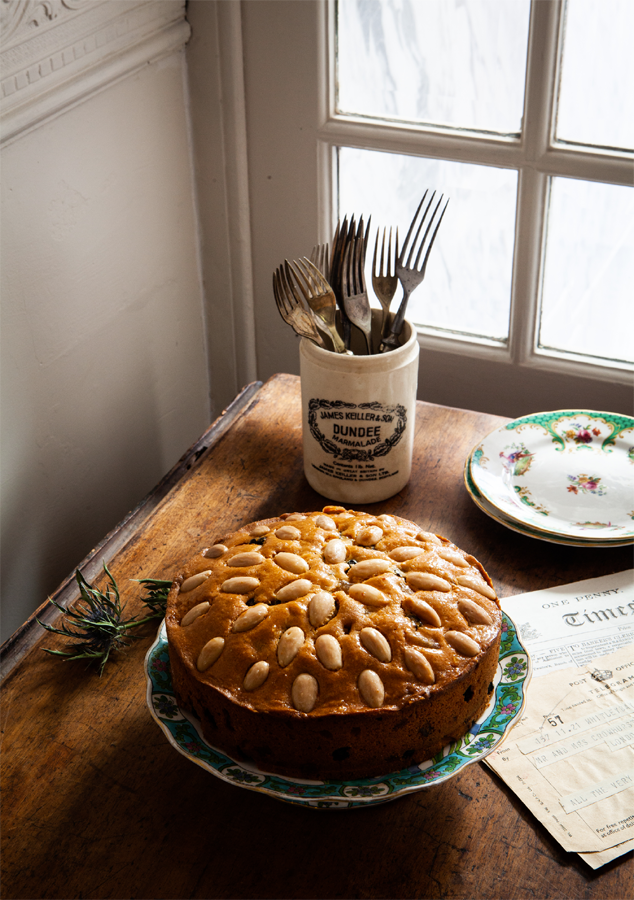
Dundee cake
According to legend, 16th-century Mary, Queen of Scots, did not like to eat glacé cherries and a lighter version of fruit cake, the Dundee cake, was developed especially for her. The real story is that the cake was invented by Janet Keiller at the end of the 18th century. She sold the cake in her shop in Dundee, where she also sold her marmalade.
Janet Keiller is the inventor of marmalade as we know it today; previously, it was cut-able rather than spreadable. Her business passed on from generation to generation and thus became the iconic brand Keiller’s of Dundee in the 19th century. Keiller’s continued to bake the Dundee cake, with its typical decoration of almonds, on a commercial scale to use their surplus of orange peel. The cake was a by-product of marmalade making and something for the company to produce outside the orange season. The almonds, sherry and raisins arrived from Spain by boat, just like the Seville oranges, in the port of Dundee, which helped maintain the company’s relationships with the Spanish sellers. The cake shows the landscape and richness of the import port of Dundee.
Soon after Keiller’s commercialised the cake, other cake makers followed throughout Great Britain, who also offered the cake in a cookie tin and delivered it worldwide. Today, real Dundee cake can only be made in Dundee and under strict rules regarding the ingredients and method. There are no spices in Dundee cake, but you can always add them.
For 6–8 people
For the cake
150 g (5½ oz) butter, at room temperature
150 g (5½ oz) light brown sugar
3 eggs
200 g (7 oz) plain (all-purpose) flour
1 tbsp sherry
100 g (3½ oz) candied orange peel, finely chopped
zest of ½ orange, grated
25 g (1 oz) almond meal
1 tsp baking powder
pinch of sea salt
175 g (6 oz) raisins
butter, for greasing
flour, for dusting
40–60 g (1½–2¼ oz) blanched almonds, to garnish
For the sugar syrup
1 tbsp white sugar
1 tbsp water
For a round 20 cm (8 inch) springform tin
Preheat your oven to 180°C (350°F) and prepare the cake tin (see here).
Put the butter and sugar in a bowl and beat until creamy. Add the eggs, one at a time, and make sure that each egg is completely incorporated before adding the next one. Add a teaspoon of the flour with the last egg to prevent the mixture from separating. Stir in the sherry, candied peel and grated zest.
Carefully fold the remaining flour, the almond meal, baking powder and salt into the batter so that the volume is retained. Stir in the raisins, then spoon the batter into the tin and smooth the top.
Arrange the whole blanched almonds in concentric circles on top of the cake. Don’t push the almonds into the batter – lightly place them on top, otherwise they will sink into the batter during baking.
Reduce the oven to 150°C (300°F) and bake the cake in the lower part of the oven for 50–60 minutes.
Meanwhile, make the sugar syrup by mixing the sugar and water in a small saucepan and heating over low heat until the sugar has dissolved.
Cover the hot cake with the sugar syrup. Allow the cake to cool completely in the tin. It tastes best after a few days, stored in an airtight container.